VistaVision Visits the TCL Chinese | Read more at in70mm.com The 70mm Newsletter |
| Written by: Paul Rayton (Hollywood) and Thomas Hauerslev (Bakkebølle) | Date: 03.05.2025 |
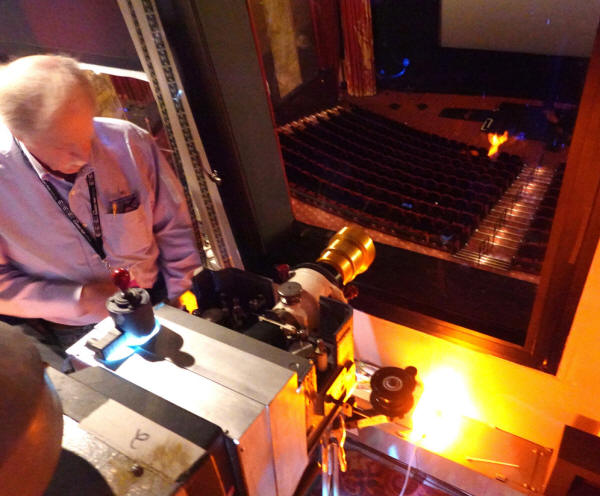 Chapin Cutler of Boston Light & Sound next to the Century VistaVision 35mm projector. Picture: Paul Rayton Chapin Cutler of Boston Light & Sound next to the Century VistaVision 35mm projector. Picture: Paul RaytonTCM Classic Film Festival in Hollywood, USA recently (25-27. April, 2025) showed two films in VistaVision, the large 8-perforation double-frame format dating back to 1954. The films were “Gunfight at the O.K. Corral” and “We’re No Angels” and shown at the TCL Chinese IMAX [originally Graumans], Hollywood, CA, USA. What is VistaVision? VistaVision is standard 35mm film turned on its side, running horizontally through modified 3-strip Technicolor cameras. VistaVision was jointly developed by engineers and camera specialists at Paramount Pictures and Technicolor as a method of photography to create better conventional 35mm widescreen prints. • Go to Berg der Kinoträume • Go to The Paramount VistaVision Process • Go to Horizontal VistaVision Projector • Go to Perspecta Stereophonic Sound Basic Principles VistaVision was not originally intended or expected to be shown in the 8-perf format in cinemas. However, with the approach of the release of "White Christmas" in 1954, being the first film photographed in VistaVision, the decision was made to "go big" and create special 8-perf prints and show them with custom made 8-perf projectors. In an amazingly short time, the Century Projector Co. designed and manufactured a limited number of machines - two of which were actually used at this TCM festival. The film path runs from the lower reel, up through the machine from right to left, as seen looking towards the screen - just like 70mm IMAX. In 1956 Technicolor had taken VistaVision a step further and added a Dutch Delrama 1,5x anamorphic lens to the camera lens. Thus Technicolor created the Technirama process (Short for Technicolor and Delrama), to enable anamorphic 8-perf photography, and flat and anamorphic print downs to 8mm, 16mm and 35mm, as well as making large format Todd-AO styled 70mm prints known as Super Technirama 70. VistaVision cameras and projectors went into storage around 1960, and did not re-surface for several years when the cameras were dusted off, and used for special effects photography for many films productions, most notably for “Star Wars”. VistaVision was a cheaper alternative to using 65mm large format photography, and anamorphic prints could easily be extracted from the 8-perf negative. | More in 70mm reading: in70mm.com's page about VistaVision Berg der Kinoträume: Paramounts VistaVision in70mm.com News Peripheral Vision, Scopes, Dimensions and Panoramas in70mm.com's Library Presented on the big screen in 7OMM 7OMM and Cinema Across the World Now showing in 70mm in a theatre near you! 70mm Retro - Festivals and Screenings • For more details go to Bill Counter's fantastic page: Grauman's Chinese: VistaVision at the 2025 TCM Festival |
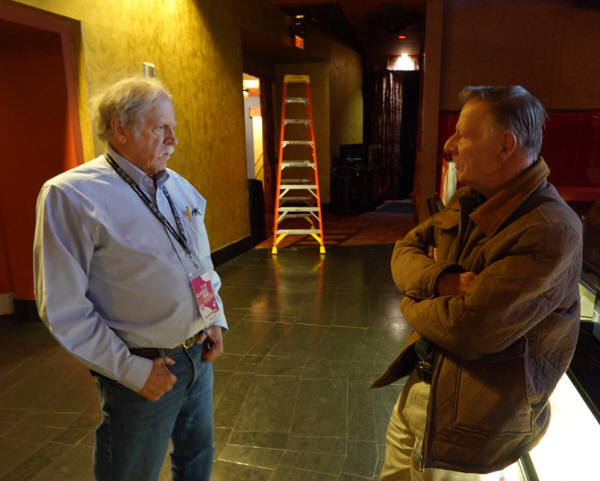 Legendary co-owner of Boston Light & Sound, Chapin Cutler (L.), and legendary projectionist at the Chinese (for 18 years), as well as on the lot at Paramount for many more years, Mike Schleiger (R.) in the lobby of the historic Chinese Theater, Hollywood. Together they share a vast amount of VistaVision experience from over the years. March 24, 2025. Picture: Paul Rayton Legendary co-owner of Boston Light & Sound, Chapin Cutler (L.), and legendary projectionist at the Chinese (for 18 years), as well as on the lot at Paramount for many more years, Mike Schleiger (R.) in the lobby of the historic Chinese Theater, Hollywood. Together they share a vast amount of VistaVision experience from over the years. March 24, 2025. Picture: Paul RaytonProjector set-up For the unique 8-perf presentation at the TCL Chinese IMAX. Boston Light and Sound provided two vintage Century machines capable of running 8-perf prints. • Go to Gallery VistaVision presented at the TLC Chinese Two machines were installed bookending a pair of Christie digital machines. No sound reproduction required (or possible) from off the film in these projectors. All the audio was being done by a synced system using the "ProTools" audio suite of apps. Doing it this way is becoming rather common in Hollywood by now. Sound playback did include the effects of the original Perspecta directional sound on “We’re No Angels”. Director Paul Thomas Anderson also had a true VistaVision trailer made for his own forthcoming “One Battle After Another” printed in the horizontal, 8-perforation format, which screened at the TCM Festival ahead of the feature films. Ahead of the 1-day-only screening, months of projector preparation in the BLSI's Boston based work shop was generously documented in pictures and text by Sean McKinnon (Department Manager for AV Integration & Specialty Presentations). All adding to the buzz, about the "return" of VistaVision for the first time in more than 60 years. Of course, VV never really went away, as it had been used in post production work for many years. | |
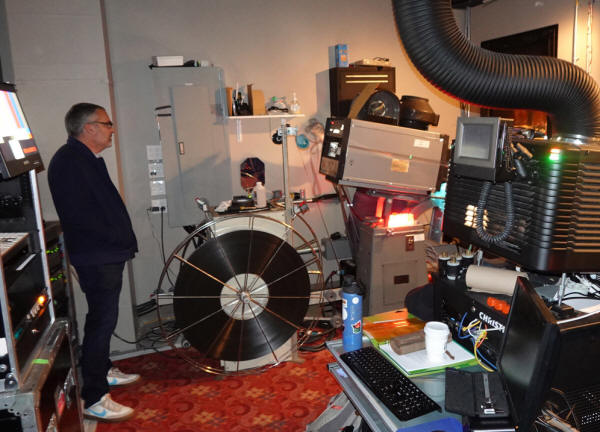 Century VistaVision projector #1 with Kinoton reel tower behind it. Using the "traditional" method of identifying machines in projection rooms if this was a permanent installation, they would be numbered sequentially, from left to right (while facing toward the screen). So, in the Chinese situation, the VV machines would be "#1" and "#4", with the two digital machines in the middle being projectors #2 and #3. Picture: Paul Rayton Century VistaVision projector #1 with Kinoton reel tower behind it. Using the "traditional" method of identifying machines in projection rooms if this was a permanent installation, they would be numbered sequentially, from left to right (while facing toward the screen). So, in the Chinese situation, the VV machines would be "#1" and "#4", with the two digital machines in the middle being projectors #2 and #3. Picture: Paul RaytonFestival Notes Paramount’s Charlotte Barker, responsible for the TCM screenings, and director of film restoration at Paramount Pictures introduced the screenings by saying:
In reality there is not much hocus-pocus about 8-perf VistaVision - it is basically the same format known from any 35mm still-picture camera. In fact the roller coaster ride in “Indiana Jones and the Temple of Doom” was photographed frame-by-frame as stop-motion "in VistaVision" (but not credited like this) with a Nikon camera, and later converted to anamorphic 35mm film and blown up to 70mm for theatrical presentation. | |
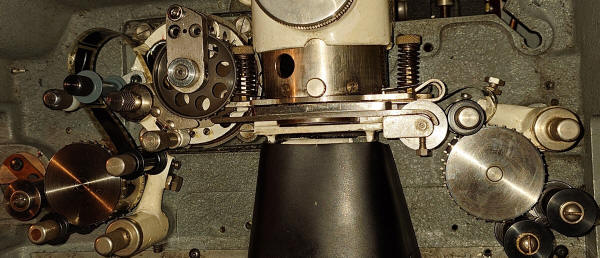 Actual VistaVision film path. Film enters from right side, passing over the feeder sprocket, going into a loop, before travelling through the film gate right-to-left. The intermittent sprocket pulls the film through the gate and into a loop, until the film strip leave the projector, passing through the hold back sprocket to the left. Picture: Thomas Piccione (BLSI) Actual VistaVision film path. Film enters from right side, passing over the feeder sprocket, going into a loop, before travelling through the film gate right-to-left. The intermittent sprocket pulls the film through the gate and into a loop, until the film strip leave the projector, passing through the hold back sprocket to the left. Picture: Thomas Piccione (BLSI)Conclusion It's the first time VistaVision has been projected theatrically for an audience for decades, but VistaVision has been projected for studio "process" shots more or less continuously since the 1960s. It's a special purpose use with 35mm film, but it's not exactly "unknown". It's has not been commonly used for commercial daily projections, though, because the technical hurdles to make it all happen successfully are significant. To be realistic, It's would be much easier to make a conventional 70mm print from the VV negative, which preserves as much of the captured information as possible, and run it on any of the dozens of 70mm film projectors that are still installed around the world. The projected image area is roughly the same -- or even exactly the same -- and the headaches are reduced about 90%. And the normal 5-perf pulldown 70mm projection is a mature technology that offers splendid physical projection characteristics without having to spend (as a guess) $20,000+ on a custom projector installation. But, of course, where egos and "firsts" are involved, cost is no object! | |
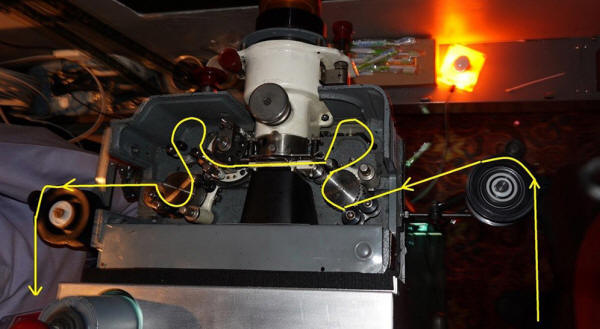 To illustrate how VistaVision film travel through the Century 35mm projector, follow the yellow line. Picture: Paul Rayton To illustrate how VistaVision film travel through the Century 35mm projector, follow the yellow line. Picture: Paul RaytonVistaVision in 70mm: • Go to "The Searchers" • Go to "Vertigo" • Go to "North By Northwest" • Go to VistaVision presented in 70mm 8-perf 35mm photography has remained a popular format for many years, and recently two major motion pictures “The Brutalist" (2024) and “One Battle After Another” (2025) have been photographed this way. Two short films "Ellston Bay" (2018) and "The Negative" (2016) were also "made in VistaVision". | |
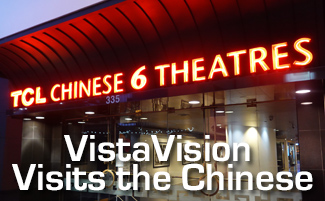 • Go to VistaVision at the TLC Chinese | |
| Go: back - top - news - back issues Updated 11-05-25 |
